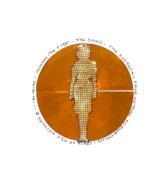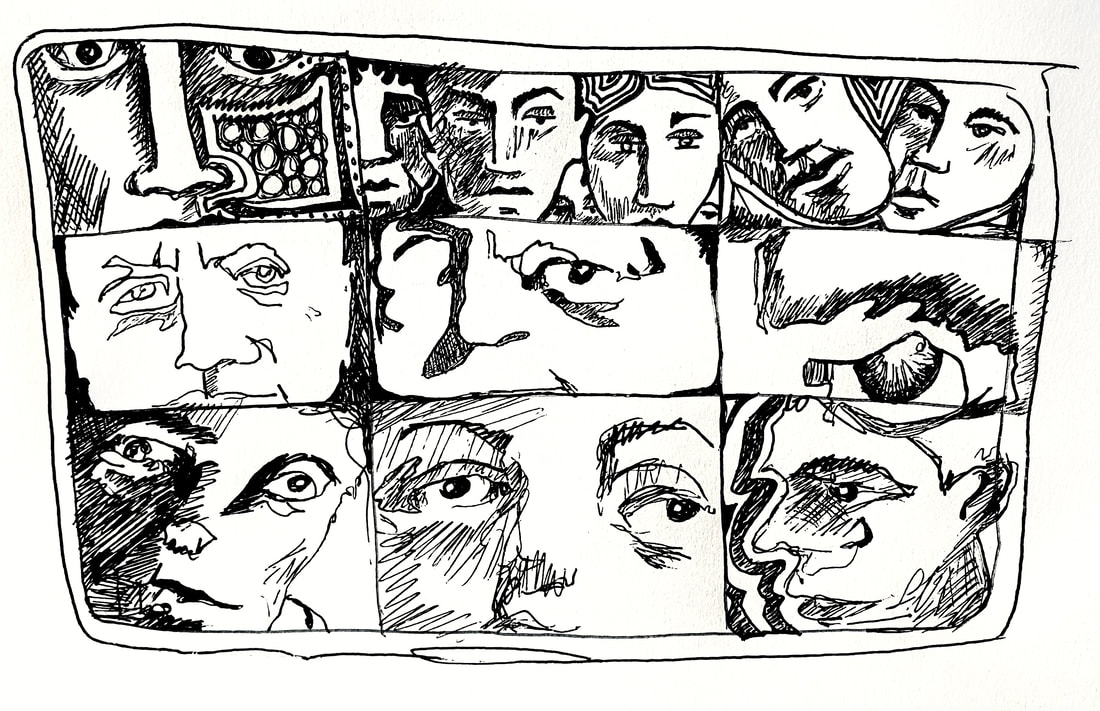Sometimes when I’m thinking about an idea or concept, I like to make a loose grid (this one is 6.5x4”) and then make several drawings in the grid playing around with the idea. It’s small enough that I can do it relatively quickly and move an idea along. I started out with the top row moving left to right, drawing just faces that I normally draw out of my head and then moved into doing contour drawings with the rest. I’ve been thinking about shadows and how it’s hard for me to do a drawing or painting unless I know where the light is, it’s hard for me to abstract it because in my head it looks weird if you don’t have the light in the right place. I sometimes tend to overthink things. I wanted to do this grid and play with the shadows. Of course my original idea changed when I started doing the contour drawings because I started doing contours of the shadows that I was seeing and I didn’t want to do the original thought. You can see how the idea changed when I started doing the contour drawings. That’s ok though because the whole idea of this grid exercise for me is to see where it will take me and it’s ok if it’s not where I planned to go. It becomes a journey, an adventure.
I can’t do a study on an idea without researching it a bit. Technically, a shadow is a dark area where the light from a light source is blocked by an opaque object between you and the light source. The wider the light source gets the more blurred the shadow becomes. What that comes down to is that shadows are about time and space (my favorite things to think about) Seeing a shadow in a painting or drawing might give you information about the time of day or the time of year or the place they are at. Shadows give depth and 3-dimensionality. Without a shadow, your image becomes flat. Not that there is anything wrong with that and not that I haven’t done hundreds of images like that (see some HERE) A lot of traditional Japanese art is also shadowless - here are links to a couple of examples of Kitagawa Utamaro (1792–93) and Tōshūsai Sharaku (1794–1795). The idea is when you are working with ideas in a grid it gives you the opportunity to play around and maybe put the shadows in a place they are not expected and see how it can change your reality. It’s all just an illusion anyway, a play of light.
A couple of my favorite shading techniques:
• Chiaroscuro which shows an abrupt change from light to shadow when the person or object is in strong light. Rembrandt and Caravaggio are, of course, great old school examples of this. Another good example is Amélie Beaury.
• Sfumato is kind of the opposite of Chiarascuro, it’s a softening transition between colors like smoke, a fine shading. Our old school example would of course be Leonardo daVinci and a more modern take would be Gerard Richter - please check out his self-portrait (I love it) and Sophie Pigeron (amazing work)
What shading techniques do you use in your art, feel free to post an example in the comments!
-Evelyn
I can’t do a study on an idea without researching it a bit. Technically, a shadow is a dark area where the light from a light source is blocked by an opaque object between you and the light source. The wider the light source gets the more blurred the shadow becomes. What that comes down to is that shadows are about time and space (my favorite things to think about) Seeing a shadow in a painting or drawing might give you information about the time of day or the time of year or the place they are at. Shadows give depth and 3-dimensionality. Without a shadow, your image becomes flat. Not that there is anything wrong with that and not that I haven’t done hundreds of images like that (see some HERE) A lot of traditional Japanese art is also shadowless - here are links to a couple of examples of Kitagawa Utamaro (1792–93) and Tōshūsai Sharaku (1794–1795). The idea is when you are working with ideas in a grid it gives you the opportunity to play around and maybe put the shadows in a place they are not expected and see how it can change your reality. It’s all just an illusion anyway, a play of light.
A couple of my favorite shading techniques:
• Chiaroscuro which shows an abrupt change from light to shadow when the person or object is in strong light. Rembrandt and Caravaggio are, of course, great old school examples of this. Another good example is Amélie Beaury.
• Sfumato is kind of the opposite of Chiarascuro, it’s a softening transition between colors like smoke, a fine shading. Our old school example would of course be Leonardo daVinci and a more modern take would be Gerard Richter - please check out his self-portrait (I love it) and Sophie Pigeron (amazing work)
What shading techniques do you use in your art, feel free to post an example in the comments!
-Evelyn


 RSS Feed
RSS Feed